Robin Winters
"Sometimes I may have an idea ahead of time, but usually I am changed by the process. Imagine if science was all a priori. What would be the point of doing the experiment?"
Robin Winters (b. 1950) Education: San Francisco Art Institute, Whitney Museum Independent Study Program, One-Person Exhibitions include: Berkeley Art Museum and Pacific Film Archive, CA; Mary Boone Gallery; Michael Klein Gallery; Brooke Alexander Gallery; The Renaissance Society at the University ofChicago; Brutto Gusto, Berlin; Beacon Project Space; Corning Museum of Glass, NY; Rathbone Gallery; Galerie Laage-Salomon, Paris; Centre Régional d’Art Contemporian Toulouse France ; Stedelijk Museum, Amsterdam , Marlborough Gallery, Group Exhibitions include: De Appel, Amsterdam; Dinter Fine Art; Arizona State University ArtMuseum, Temple; Paula Cooper Gallery; Witte de With Center for Contemporary Art, Rotterdam; NewMuseum of Contemporary Art; Contemporary Arts Museum, Houston; Silverstein Gallery; Plus UltraGallery; Queens Museum of Art; Whitney Museum of American Art; Centre d’Art Contemporain Geneve,Geneva , Anton Kern Gallery, MePaintsMe Gallery, Emily Harvey Gallery, Collections include: San Francisco Museum of Modern Art; The Fabric Workshop and Museum, Philadelphia; Netherlands Media Art Institute, Amsterdam; The Metropolitan Museum of Art; Smithsonian Museum, D.C.; Museum Van Hedendaagse Kunst, Belgium; Museum of Modern Art NY; Stedelijk Museum, Amsterdam ;Brooklyn Museum Publications include: Art in America, The New York Times, The Village Voice, The New Yorker, MiamiHerald, Art International, Artforum, BOMB, Elle, Avenue, Awards And Honors include: New York Foundation for the Arts, John Simon Guggenheim Memorial Foundation Fellowship, National Endowment for the Arts, New York State Council on the Arts, Engelhard Foundation Grant
MEPAINTSME: You’re originally from California correct?
ROBIN WINTERS: Yes. I am from a town called Benicia. I attribute a great deal of my “inspiration” to my experiences in this place. Benicia was the first state capital of California because the gold rush started there and it was a port for all the ships bringing the miners on their way to the gold fields, thus a “boom town”.
I read everything by Jack London because there was a historical plaque saying he had lived in Benicia. I wandered Main Street looking for jobs when I was a young kid and worked at a variety of places including the dime store, the black and white liquor store, the leather factory, and the wire wonder laundry basket factory. I also spent a lot of time looking for old bottles by walking in the mud flats at low tide or crawling under old buildings and I amassed a large collection of bottles from the 1800’s.
MPM: Interesting — glass specifically, since you’ve continued working with it as a medium to this day. Did you have any exposure to art?
RW: It was from my job inquiries and my bottle collecting that I met an artist named Manuel Neri. Neri was walking up the front steps of the congregational church carrying a taxidermy head of a water buffalo that was wearing oversized sunglasses. I had attended Sunday school in this church and I was very curious what this man was up to — plus I wanted to explore the basement and look for old bottles. I consider this encounter to be the beginning of my art education.
There was a Robert Arneson toilet in the church yard and paintings by Mel Ramos, Joan Brown, and Judith Linhares in the church, as well as many other art works. I liked making things and here was a world of making. I would help Manuel in the studio by sweeping up the plaster dust. Neri would sit for hours staring at one of his plaster figures with a half smoked cigar in his mouth, then suddenly he would take an axe and chop off a limb! Much of the time I spent in Neri’s studio was devoted to pouring through every art book, or art and fashion magazines, just absorbing a world that was completely foreign to me. Previously my favorite art was a cardboard reproduction of Rembrandt’s The Man With the Golden Helmet.
MPM: Had you begun making art around this time?
I didn’t call myself an “Artist” and had no clue as to what I wanted to do in the world. I only had impulses. I credit Robert Arneson for calling what I did “art”. He called me an “artist” when he saw my Volkswagen bus covered in collage. I was invited to local art parties where I met Roy Deforest and William Wiley. I visited Davis and I made a work where I measured everything and wrote down all the measurements in a space called “The Art Center of The World” run by the artist Lowell Darling, who later ran for Governor of California.
Arneson was renting part of a warehouse space on the waterfront in Benicia and he suggested that I get a studio space there. “A studio space?” I had no clue what this meant, but I observed Arneson’s work ethic and saw him producing his seminal work The Cook. I took him up on his suggestion and I have been living in “studio spaces” ever since.
MPM: Did you eventually go to school?
I worked in a factory during the day and I went to the Art Institute in San Francisco for night school classes. At The Art Institute I encountered Wally Hedrick and Jay Defeo, a couple of bohemians who would bring beer to their classes. Jay had a painting hidden behind a sheet rock wall called The Rose. Diego Rivera had a giant mural but it had a curtain over it, supposedly due to fear from McCarthyism. The painter, Sam Tchakalian, gave crits where he called everyone a cunt. He said to me that I was making paintings for ballerinas. Carlos Villa would introduce me to heavy hitters from New York like Brice Marden and Alan Shields.
I took a walk with Howard Fried during his performance at the Berkley Museum which ended up becoming an all night stroll through Berkley and Oakland. Judy Chicago once interviewed my mother about my mom’s “Birth Experience”. My mom told Judy, “I don’t know what the big deal is. I just took drugs and got it over with so I could go back to work.” My Mom then asked Judy if “she knew me?” She told Judy that I was a “famous artist” and gave Judy my number. I was in New York by then, but Judy had a studio in Benicia. On my next visit I went out for a Chinese dinner with Judy and Bob Arneson. We laughed about mothers and sons. Over the years I brought various creative individuals to meet my parents in Benicia. I was traveling with Marina Abramovic and took her to meet my parents. She seduced them totally by making them an apple strudel.
MPM: When did you make the transition to New York?
I came to New York in 1972 after my stint at The Art Institute in San Francisco. I was a classmate and friend of Kathryn Bigelow and she had been accepted into the prestigious Whitney program. I applied and was accepted the semester after her. So, I hitchhiked to New York and immediately was ensconced into the New York art world. (Right place, right time).
I worked at Leo Castelli Gallery bartending at an opening of artists who made furniture the first week I was in town. This led to many jobs and relationships with a lot of artists. I worked part time for Donald Judd and I was a bus boy and waited tables at the Spring Street Bar where I met Robert Smithson, Richard Serra, Marisol, Viva Superstar, and many other artists. After a year of restaurant work I started to freelance, doing painting jobs and assisting various artists with their work. I helped Gordon Matta Clark, Robert Whitman, Robert Ryman, Dennis Oppenheim and Joan Jonas. I worked on several of Joan Jonas’s early performances and was in her film “Song Delay”.
MPM: I heard in an interview that when you first arrived in New York you would draw pictures (sometimes with notes) and leave them on the streets for others to find. This notion of connection through discovery seems to recur in later projects, like your participation in a project in Ghent where you hid drawings in books. Can you talk about this impulse and those projects?
RW: I have an ashtray that I’ve had for years. It is an image of a hand and the caption on it reads “Secrets of the hand, Mysteries revealed Destiny’s divulged.” I guess that sums it up. Hahahaha.
I mean, think of “image trouvé” foundlings, delightful finds, fortune cookies, etc. Considering the level of branding and marketing that is currently de rigueur one might consider anonymity to be a rarity.
MPM: Looking back your output as an artist is really remarkable, spanning several forms that include performance, poetry, painting, installation, sculpture, glassblowing and video to name a few. As a child was your interest mostly in visual art or did you have a similar impulse to express through a variety of activities and forms?
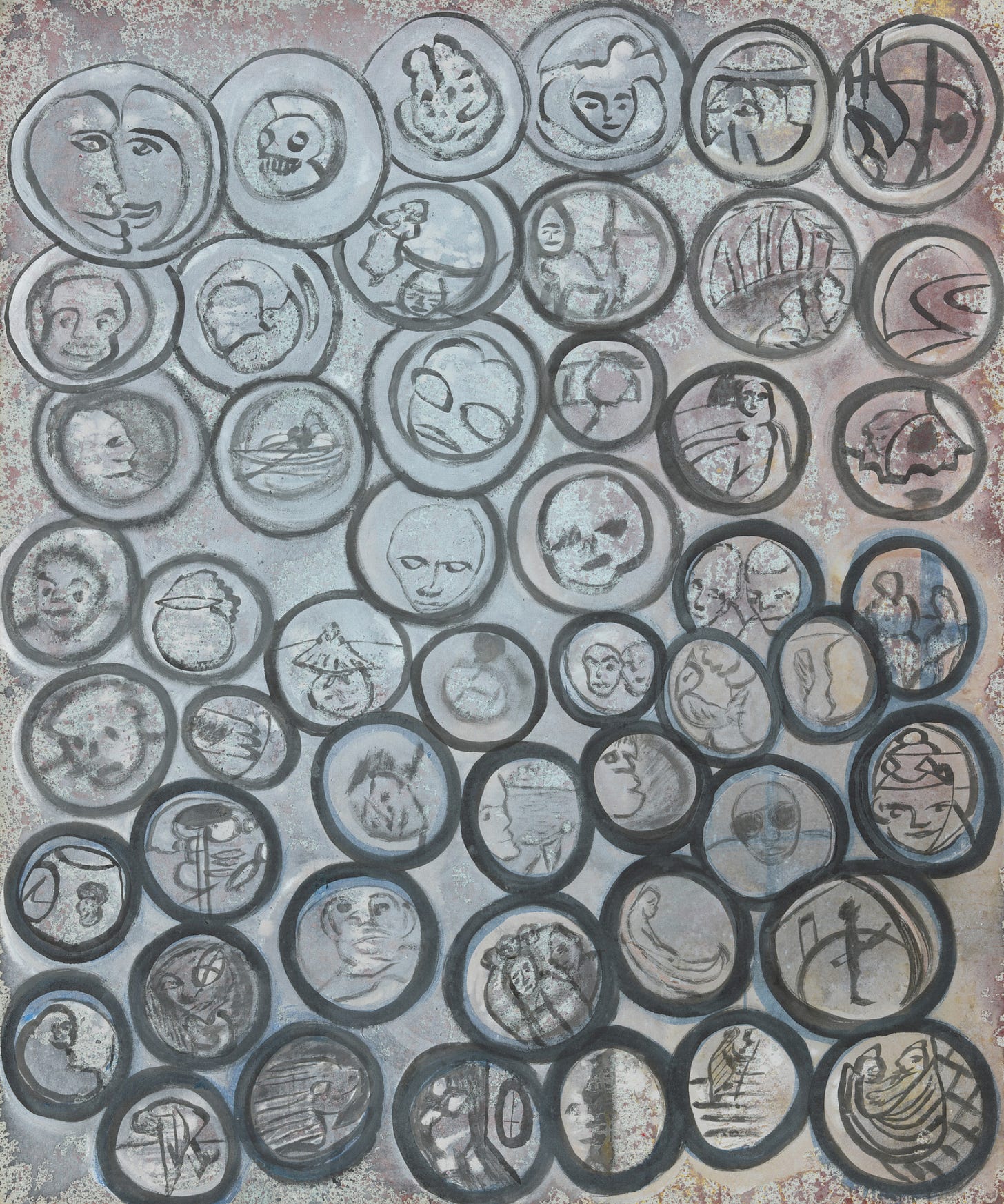
RW: As a child I loved animals. I had many cats starting with a stray cat I found half dead on the street. I raised chickens beginning with a banty rooster that was missing toes from cows stepping on its feet when he would try to herd them around. A farmer in Canada gave him to me when I was on a family trip. I actually smuggled the rooster across the border through customs.
My family had dogs, including a Saint Bernard that would pull my sister and I, dressed in various costumes, in parades down Main Street. My ambition at that stage in life was to be a veterinarian. I have been privileged to have many creature friends over the years. Shadrach, Silver, Evie, Sadie, Lucy, Rosie, Jay, Robin, Cleo, Leo, Nebuchadnezzar, Meshach, Sinbad Abednego, Ninja, Sparky, Pancake, Flipper, Poco, Mouchette, Grisette, Gordon, and George to name a few.
MPM: There’s a mischievous playful bent to a lot of your work. Where does this originate? Would you say you were a mischievous kid?
RW: I remember several occasions of a performative nature from when I must have been around six years old. I was a latch key kid and my parents were often working late at their law office. My father did criminal law and my mother did family law. The John Birch society attacked them for their politics and called them communists.
I was confused as to what a communist was, but I wanted to defend and celebrate my parents, so I made myself a costume and an armband with a swastika on it thinking that I was supporting communism! My mother was horrified and sat me down in an attempt to explain the difference between communism and fascism. It is interesting now how the current administration conflates these terms when hurling insults at the opposition.
I like to think that I always had a sense of humor but I think that my “mischievousness” might stem from all sorts of childhood abuse that naturally leads to defiance. I have an anti-authoritarian nature that includes refusing to salute the flag or participate in the war machine.
I was a war resister during the Vietnam War and faced federal prison time for my refusal to register for the draft. An early “artwork” of mine was an old VW bus that I collaged with army men and civil rights workers and burned draft cards. I called it “The Norman Thomas Memorial Traveling Museum”. I would often go to local draft boards with my bus and hand out anti-war information about how to resist the draft.
MPM: Early on you also did a lot of performances, including a two month long performance at the Whitney Museum’s 1975 Biennial Exhibition entitled W.B. Bearman Bags a Job or Diary of a Dreamer. Can you talk a bit about these and other performances from that period?
RW: My first public performance was entitled The Secret Life Of Bob-E or Bob-E Behind the Veil. I was performing as a character, Bob-E, who was a magical factory worker. His goal was to make a monument to everyone in the world in the form of a hat. I constructed a wall that had installed a two-way mirror dividing my studio into an audience space and the workplace of the character Bob-E. The mirror functioned as a window for the audience, but the performer, Bob-E, could never see who was watching.
In The Secret life of Bob – E the audience could view the performer, but the performer could not see the audience. I was familiar with a combination of art works and psychological experimentation that preceded this work, including Claes Oldenberg’s store performances and Dan Graham, Joan Jonas, and Robert Smithson’s use of mirrors as well as The B.F. Skinner box and interrogation rooms.
Marcia Tucker, a curator at the Whitney saw this work and invited me to be in the 1975 Whitney Biennial. I proposed a sculptural performance room with a two way mirror in one corner of the room behind velvet curtains. The signage on the wall said “Booth with live performer”. This would be a joke for some viewers who upon entering past the curtains would encounter their own image. I was in control of the mirror and would sometimes not let people see inside so they thought the piece was about their own image. Inside the “Booth” I had a variety of props including a bear mask, a bird mask, and a bull mask. I was constantly active, repetitively doing something, either dancing or drawing or making ceramic cups formed on my elbow.

For two months, daily, during regular museum hours, I came in and performed behind the two way mirror. It worked both ways, meaning I could reveal, conceal, or make a double negative where the viewer’s face would merge into my own. I would wear my bear mask on the 6 train and go into the museum in my pin striped suit and bear mask where I would clock into my room. Tom Armstrong, the director of the Whitney objected saying that I was “extending” my work into the museum. My response was “Isn’t that what every art work is attempting to do?”
My intention in this work and subsequent works was to produce a fictional character in real time and space. I suppose that this was a form of distancing or disassociation that I am still in the process of unraveling. In fact I probably consider myself to be more of a fiction writer who has created a persona of “An Artist.”
MPM: Tell me about your performance piece titled Take the Money and Run Didn’t it consist of robbing your audience!?
RW: That work I did in collaboration with Coleen Fitzgibbon, and we did not “rob” people, rather we challenged the audience’s participation or complacency in attending a performance where they became willing victims of what was an intentionally oppressive activity. We had seen performances in this type of venue where the artist would do such things as cut themselves with a razor blade while the audience stood and watched. Ultimately our action was an anti-fascist critique. We only held hostage the possessions of the audience after giving them every opportunity to leave the performance. The official title of this work was Imported American Artists Take the Money and Run. We called our collaboration X & Y offer.
This collaboration expanded into an office of artists titled The Offices of Fend, Fitzgibbon, Holzer, Nadin, Prince, and Winters (Peter Fend, Colleen Fitzgibbon, Jenny Holzer, Peter Nadin, Richard Prince, and Robin Winters).

MPM: I hadn’t realized that collaboration had always been such an important facet of your practice.
RW: Over the years I have participated in many collaborative situations, including group collaborative projects and acting in films by Joan Jonas, Zoe Belof, Beth and Scott B, Vivianne Dick, and recently Tessa Hughes Freeland.
My work has appeared as Record album covers for the bands “Blue Crime” and “Rova”. I also designed and produced a set for Gregory Corso and Nico for the perfor2 festival in Rotterdam.
In each chapter of my life there are many names and personalities, so many that I once made a conveyor belt titled “River of Names”. I am skimming the surface of my interactions with the souls I have encountered. For each name I have “dropped” there are hundreds of names I have left out. In fact this entire interview could be nothing but names with links and it would end up being a map and a family tree. I apologize for all the names I did not mention because I remember everyone. John Baldessari invited me to participate in a beautiful work titled Your Name In Lights in which one’s name would be displayed on a huge LED sign and it appeared in Australia, the Netherlands and France. Each participant was notified as to the exact time and location their name would appear.
In my loft on Broadway there have been many events including my momentary collaboration with Sarah Charlesworth, “Atelier Bricolage”, and “The Batman Show” with Diego Cortez, as well as the “Key Club” where I invite an artist to do an installation/exhibition. There have been many “Key Club” events including Dakin Platt painting the entire space in a wrap around graffiti style mural, Zoë Argires showing her paintings made in situ, and the artist “Shirt” doing a silent rap moment off my rooftop while maintaining a reading room. The majority of these events also have included a dinner party for the artist and their guests.
MPM: My first encounter with your work was a show at Brooke Alexander in 1990 — a series of busts/heads made from various materials including bronze and blown glass. How did you get involved with working with glass?
RW: I previously mentioned my extensive bottle collection that made me curious about the actual process of making glass. Box molds, whittle molds, three part molds, applied tops, inside threads, etc.
My actual first experience in a glass studio came about because I made a painting called The Glass Blower. A glass artist named Tracy Glover saw an image of my painting in a Department of Cultural Affairs listing for student apprenticeships. Glover was a student at Rhode Island School of Design (RISD) and wanted a semester of independent study in NYC.
Tracey and I worked together and she introduced me to the “hot shop” at RISD. The director of the glass program, Bruce Chao — he liked what I was about and hired me to teach. The students helped me make my work and taught me the fundamentals of glass blowing.
Later in my career I took Tracy to Factory Val St Lambert in Liege Belgium along with another glass artist, John Drury, whom I met when I was a visiting artist at Pilchuck glass school in Washington. Together as a team (with Tracy Glover being the “Gaffer,” meaning the main glass blower) we made my series Testa Coranata or crowned heads. The piece was made up of 99 life size heads and hats made from lead crystal. Crazy enough, Val St Lambert had in its almost 200 year history never had a woman gaffer before! Glover owns a glass studio/hot shop in Providence RI.
I built my own glass studio upstate in the Catskills with furnace building advice from Dick Marquis and the technical expertise of Michael Scheiner. I made glass and ceramic work there for over ten years.
MPM: Three works from your recent series of watercolors that incorporate glass were included in the MPM/IRL show I curated recently. Can you talk a bit about how those came about?
RW: I made a group of hanging vases that used glass hooks to support them like old fashioned picture hangers. I had some extra glass hooks and I put a sheet of paper on one. I liked the result and now I’m constantly putting my drawings on glass hooks.
Let’s say I’m hung up or that, I’m constantly on “tenterhooks”.
MPM: When you begin a work do you have a specific purpose or image in mind?
RW: I like the apocryphal story of Caravaggio finding his images by throwing ink-filled rags at the wall and seeing the resulting images in the splatter.
Sometimes I may have an idea ahead of time, but usually I am changed by the process.
Imagine if science was all a priori. What would be the point of doing the experiment?
MPM: Your poetry is something I only recently encountered. You’ve written poems for friends and acquaintances on social media—can you talk about this practice?
I saw that Facebook listed people’s birthdays daily so some ten years ago or so I started sending birthday poems to people who list their birthday. Here is an example:
Adoration
A horse leans their head on your shoulder (wanting to talk with you)
Birds bring you gifts (a blue jay took my mothers ring and replaced it with corn)
The golden world asks you questions and gives you answers (what is next?)
We are picked from the swirling bin of circulating energy (fish in a net)
Our return ride is an age-old question (where are we going and when do we leave?)
An elephant in the zoo gives you special attention (seems to know you somehow)
A river is receiving silver ripples from a clear stream (sprung from the mountain)
Sex is announcing itself in everything on a daily basis (take it or leave it)
There is a rare air that seems to be inhaled by the pine forest (exaltation)
Such enthusiasms are natural for a child and lost to adults (renegotiate life’s joy)
You know how they say, “you are only as old as you think you are” (let go)
It seems that special events can trigger positive changes and resolve (birthdays etc)
A new year can begin at any moment you decide (a drawing as a marker in time)
This may be a self-help manual or positive re enforcement statement (just a hello) I am sure you have seen dogs with wheels for back legs (turtles who win races)
We are lucky for the beauty of the everyday moments (ice hanging like jewels)
If you are having a hard time pick a moment of sheer happiness to remember (light)
Do you think an animal has dark existential despair? (Basic survival is a reward)
A cat purrs the dog lays down by your side a little child runs with laughter (oh!)
Hey don’t get me wrong not everything is rainbows (the ground is filled with blood) Meanwhile the traffic rolls by and the wind shakes the trees (we do what we can)
We do what we must but it’s always good to remind oneself of the fresh (repair)
A parrot says, “fuck off” the phone rings It’s the bird who made the sound (laughs) Good morning Good Afternoon Good night to be continued (and we go on)
xxx
Robin
MPM: I’ve always understood the conceptual bent to your work is that of a romantic, driven by real feelings and the magical and restorative possibilities of art. Would you agree that there are these dimensions embedded in your visual imagery?
RW: I concur!
Magic is real!
Every illness has an image.
“The trickster makes this world”
MPM: What are you currently working on? Do you have any upcoming shows or projects you’d like to mention?
RW: My most recent work is made with aqua resin and incorporates bronze that I made much earlier. It is a ring composed of 35 blocks each with a bronze totem figure on top. It is as of yet untitled, though an earlier ring of 35 blocks made with ceramic, glass, and cardboard alphabet letters was titled “Letter Ring”
I am also working on a group of books in collaboration with the artist, author, designer Raina Wellman.
We are putting together a series of books that we are aiming to publish including a novel filled with pictures, drawings, and paintings called Freedom of Sleep and various projects documenting historic performances and installations including The Ghent Project from Chambres des Amis.
MPM: Wonderful. Well listen it’s been a great conversation. Thanks so much!
RW: Of Course.



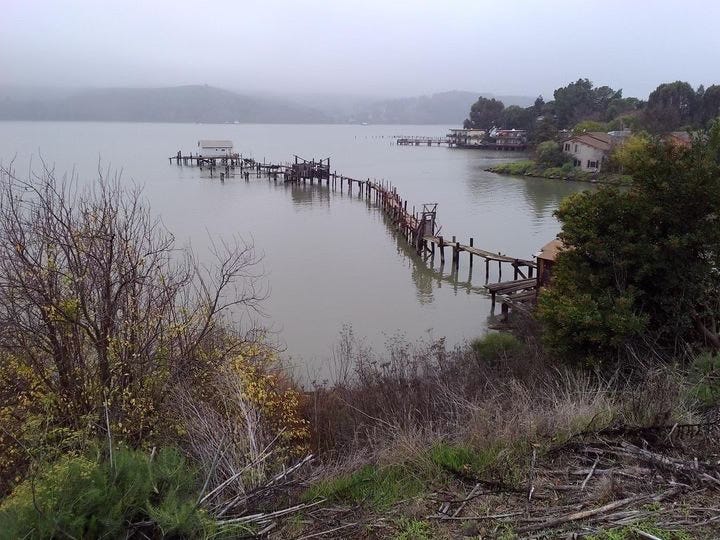
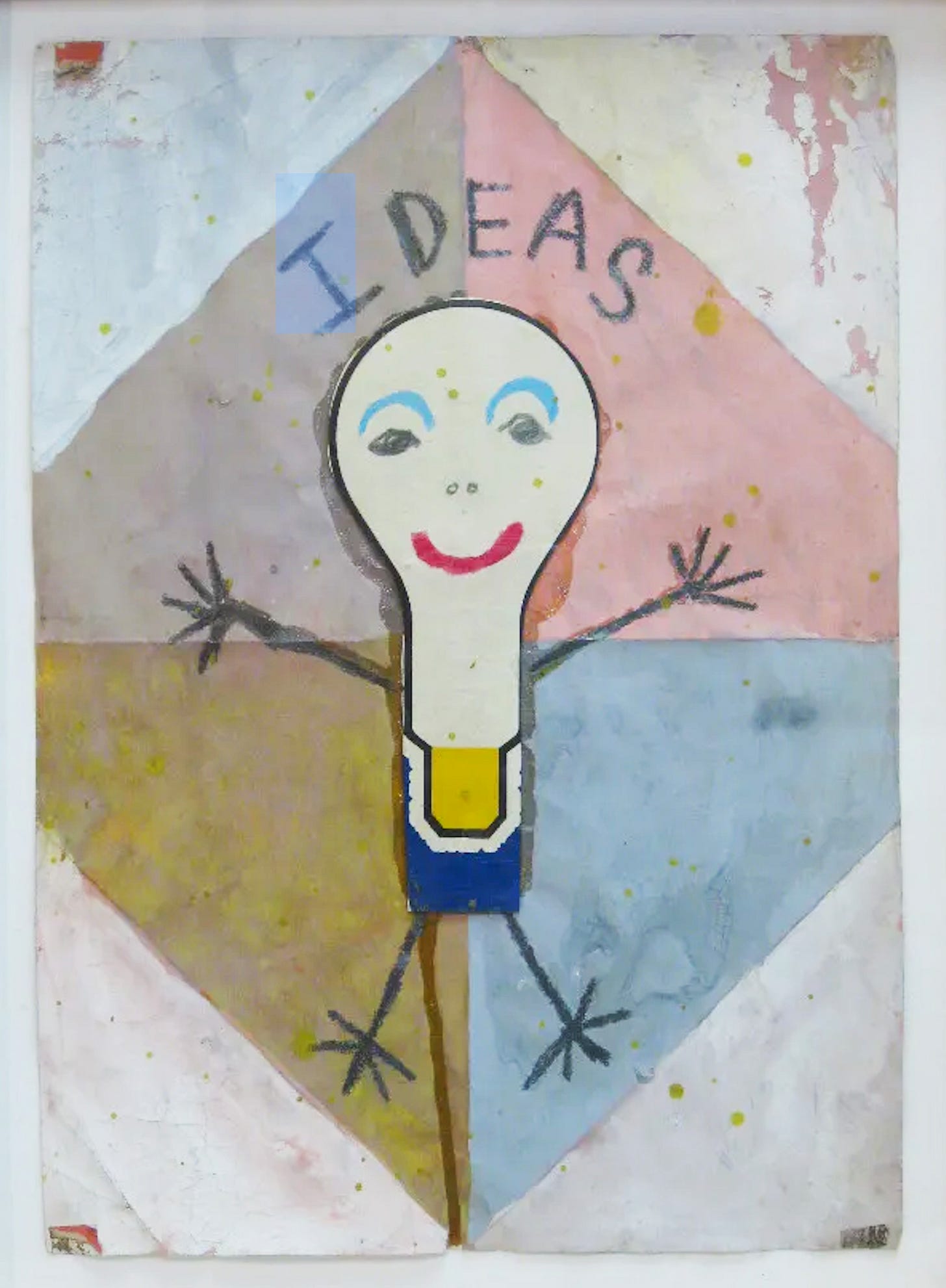
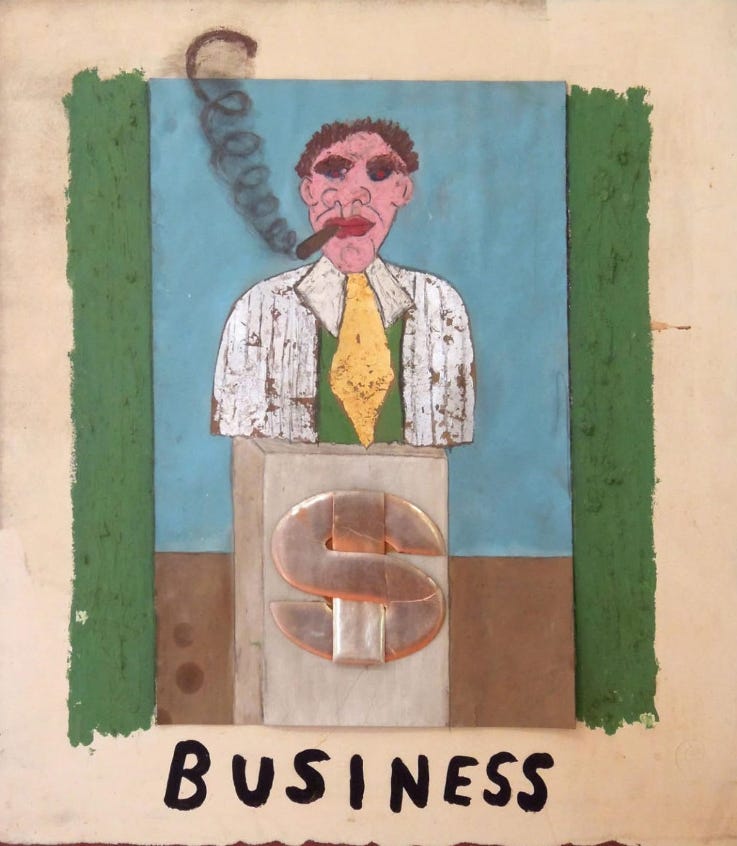

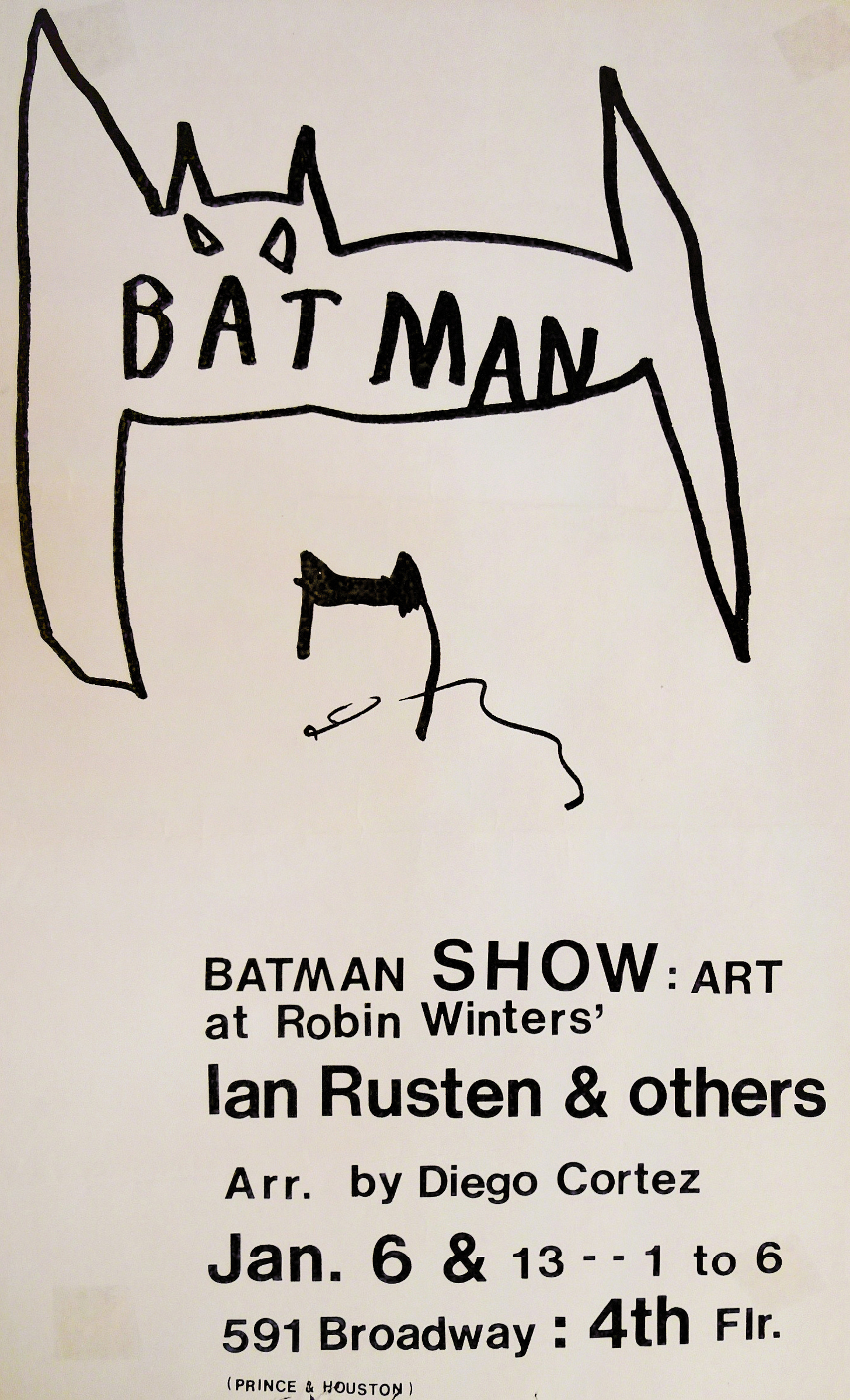

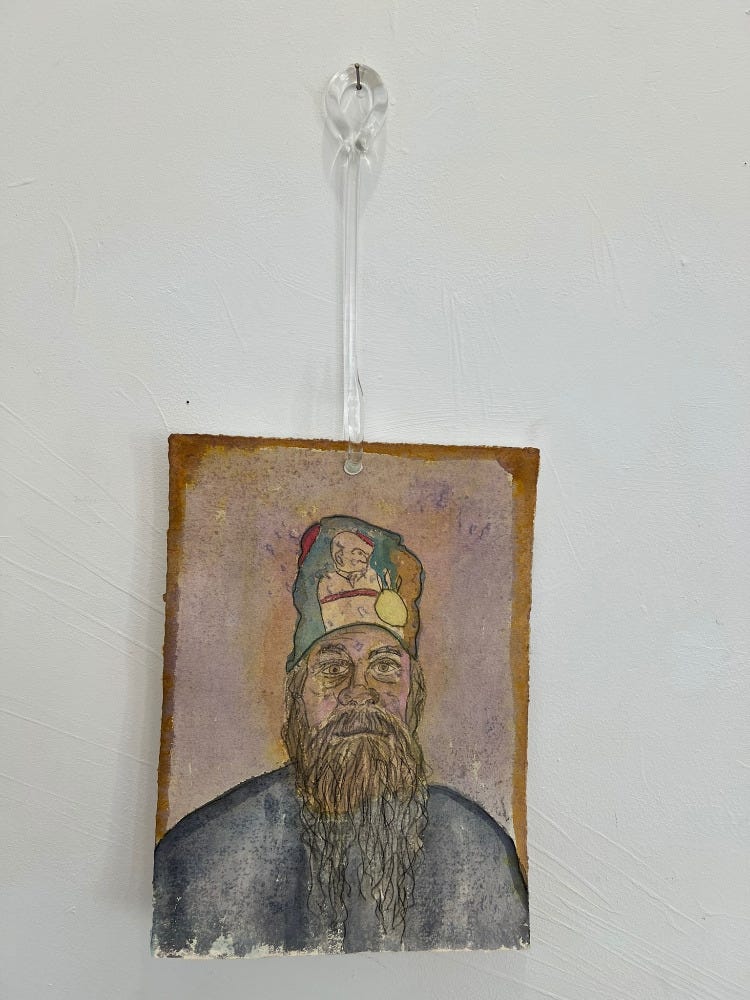
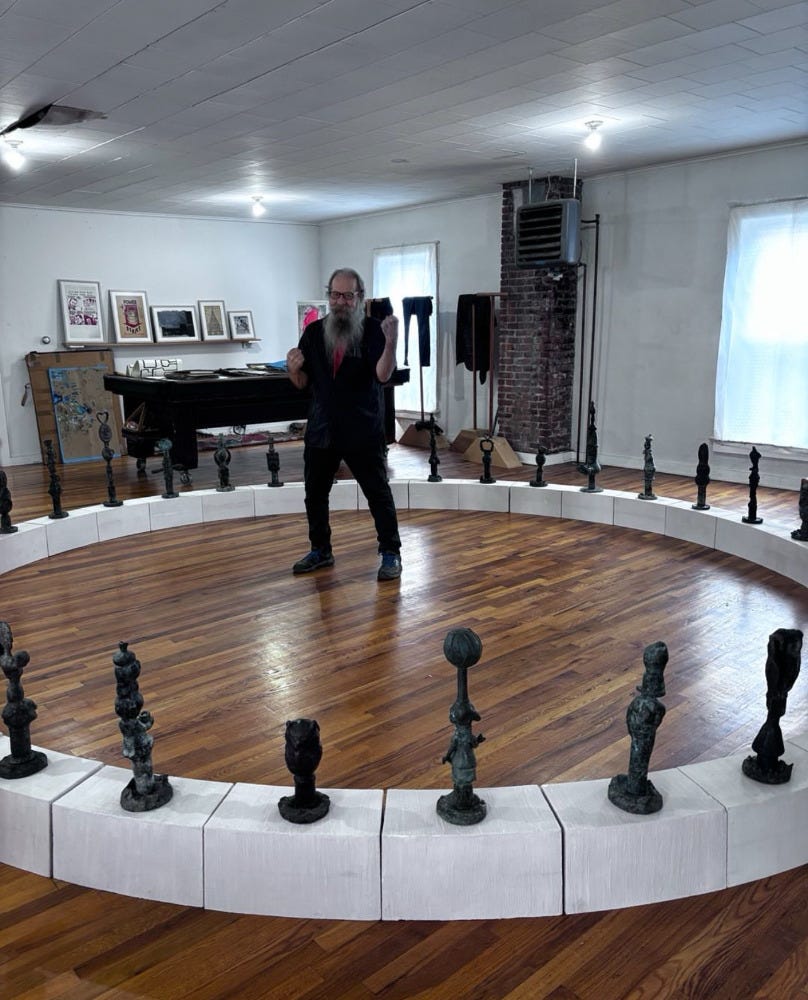
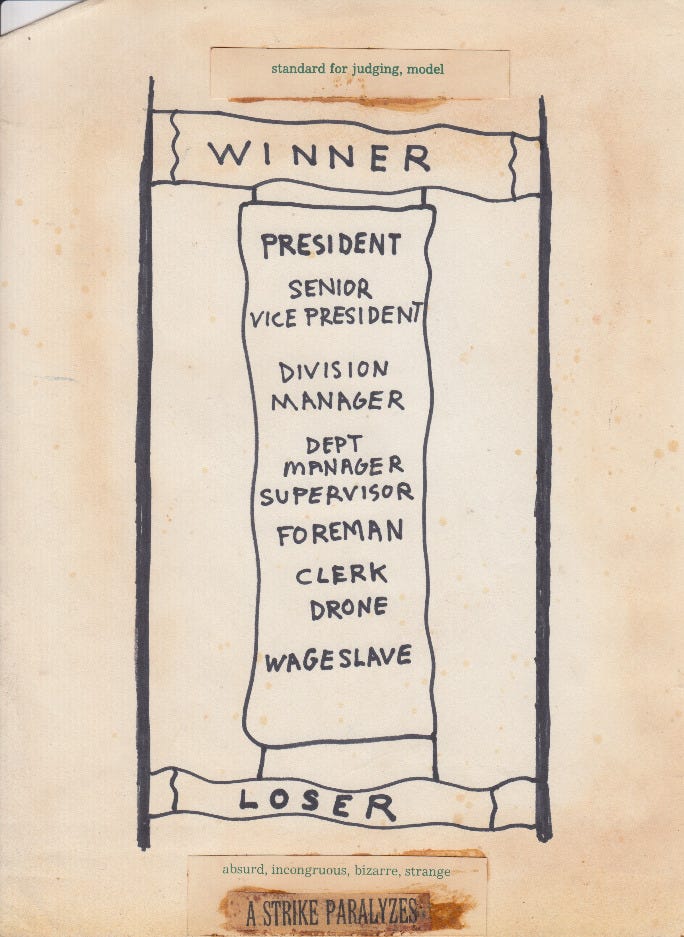
This interview with Robin Winters tells it like it is/was in a time when degrees and school learning was not required. Being fearless and confident was what it took to be a part of the changing world. Glad to see mr. Natural is roaming free rubbing sticks together making mischief love you Robin
Never knew much of this about you,Robin. Fantastic... magical!